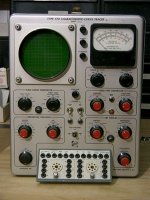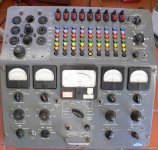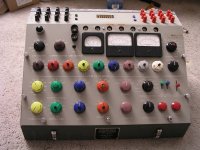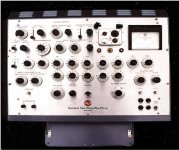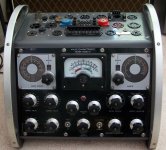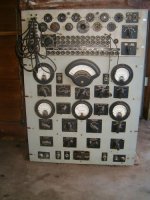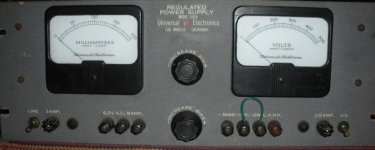Greetings everyone,
So what is the definition of matched? How close designates matched? I have one tube at idle with 29.0 ma and the other 33.7 ma.
Thanks,
Ray
That's matched within 5mA at idle
Seriously, I don't think there's a definition in your sense.
It should be specified:
- what is matched, at what conditions;
- what the match limits are.
jan didden
I have purchased matched tubes from www.dougtubes.com
Doug makes notes on the individual tube boxes which indicate Plate Current and Transconductance.
I'm not sure how he makes the measurements but in all cases, the tubes have balanced with the position of their respective bias pots in nearly the same position for each tube.
I would like to find out how Doug measures the performance of the tubes.
Doug makes notes on the individual tube boxes which indicate Plate Current and Transconductance.
I'm not sure how he makes the measurements but in all cases, the tubes have balanced with the position of their respective bias pots in nearly the same position for each tube.
I would like to find out how Doug measures the performance of the tubes.
Almost impossible to find anything matched to closer than 5% (exceptions may be noted) or so and as stated by others "matched" means quite different things from one seller to another.
Tektronix and HP matched tubes in house to quite tight tolerances, (in some cases better than 1%) and must have had very large quantities of tubes that were consigned to less critical circuit locations because there would have been very few tubes that would have met their criteria whether dual triodes or single pentodes..
You haven't mentioned what the amplifier in question is, and in PP amp this would certainly be enough to introduce significant dc imbalance in the OPT - not a good thing. Some level of adjustability is a good thing in these applications whether fixed bias or auto (cathode) bias.
In an SE amp this might result in a significant difference in distortion spectra and a small difference in output power between the channels.. Also if the target idle plate current is for example 50mA it indicates that the transconductance of the particular tube differs significantly from the design point. (And would substantially degrade the performance of that output stage.)
Tektronix and HP matched tubes in house to quite tight tolerances, (in some cases better than 1%) and must have had very large quantities of tubes that were consigned to less critical circuit locations because there would have been very few tubes that would have met their criteria whether dual triodes or single pentodes..
You haven't mentioned what the amplifier in question is, and in PP amp this would certainly be enough to introduce significant dc imbalance in the OPT - not a good thing. Some level of adjustability is a good thing in these applications whether fixed bias or auto (cathode) bias.
In an SE amp this might result in a significant difference in distortion spectra and a small difference in output power between the channels.. Also if the target idle plate current is for example 50mA it indicates that the transconductance of the particular tube differs significantly from the design point. (And would substantially degrade the performance of that output stage.)
Matching is much more in my view than bias currents and/or transconductance, and depending on the circuit topology you employ them in can be pretty meaningless. I match tubes in "sets" for all of my gear. As an example, for my SET amps, the rectifier, input/driver and output tubes all need to be matched as a set. What this means is a fuller set of specifications... signal-to-noise, frequency response, THD, voltage and bias currents, overall gain, etc. and matching internal physical construction. If you don't do this, it's unlikely you'll have two channels of amplification that measure the same much less sound the same.
Regards, KM
Regards, KM
I've been testing several sets of sweep tubes in P-P. I set idle Ib to 75 ma for two tubes and then measure each plate current. I'm finding wide variations like one tube drawing 20 ma and the other 55 ma. I only found 1 set of 6LB6's that were within a 1 ma of each other. I'm getting frustrated.
Ray
Ray
IMO electrical matching of tubes consists of matching both DC idol current at some predetermined level (no signal), and AC transconductance (Gm). For small signal tubes, one of the better home tube testers like a Hickok will probably be good enough. But for anything larger, like output tubes, home tube testers are simply inadequate because they cannot supply the higher voltages and currents necessary for the task. For this one needs a tube curve tracer, a tube analyzer, or a custom made adjustable fixture with power supplies, signal source, monitor meters and sockets etc.
Tek 570, New London 901A, Daystrom CA-1630, RCA WT-100A, Hickok 1700. (pix file too big) and maybe even an AVO. Weston 686.
Tek 570, New London 901A, Daystrom CA-1630, RCA WT-100A, Hickok 1700. (pix file too big) and maybe even an AVO. Weston 686.
Attachments
Last edited:
At first this seems like a simple truth. But in practice, it isn't. Matching requires monitoring several parameters at once which the average amplifier (if that's the circuit) is ill equiped to do without modification. Make those mods and now you have a test fixture. Easiest/best....maybe, if you have nothing else.The best and easiest place to match tubes is in the actual circuit in which they will operate.
Would this RPS be a good tool fro Testing/Matching?
I picked this up at a garage sale recently. I’m not completely sure why, but it worked and seemed like it might be useful as I gain knowledge.
Reading through the posts on this topic made me think this might be the perfect tool for testing/matching (I would use a tube tester first to check the tubes for problems). It appears to have the outputs necessary, at least for tubes with 6V filaments.
So it seems like the right time to ask those with a lot more experience and knowledge than me:
Would this work?
Any tips, instructions, schematics would be very helpful. I’m still playing with 6BQ5’s so if possible us this tube as a reference. (I promise I will move on to other tubes some day).
Some specific questions that come to mind:
If I strap the screen to test will the results be the same as if it was tested in pure Pentode mode?
If I ground the cathode and use the – bias voltage will the results be the same as using a cathode resistor to set the bias?
I could go on with questions but the answers to these will at least give me a base to work from.
Thanks
Tom
I picked this up at a garage sale recently. I’m not completely sure why, but it worked and seemed like it might be useful as I gain knowledge.
Reading through the posts on this topic made me think this might be the perfect tool for testing/matching (I would use a tube tester first to check the tubes for problems). It appears to have the outputs necessary, at least for tubes with 6V filaments.
So it seems like the right time to ask those with a lot more experience and knowledge than me:
Would this work?
Any tips, instructions, schematics would be very helpful. I’m still playing with 6BQ5’s so if possible us this tube as a reference. (I promise I will move on to other tubes some day).
Some specific questions that come to mind:
If I strap the screen to test will the results be the same as if it was tested in pure Pentode mode?
If I ground the cathode and use the – bias voltage will the results be the same as using a cathode resistor to set the bias?
I could go on with questions but the answers to these will at least give me a base to work from.
Thanks
Tom
Attachments
- Status
- This old topic is closed. If you want to reopen this topic, contact a moderator using the "Report Post" button.
- Home
- Amplifiers
- Tubes / Valves
- Definition of matched
